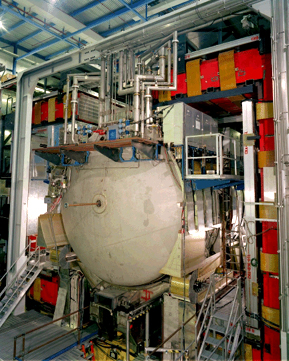BU Physicists Seek Theory of Everything
Top quark discoveries offer clues to early universe

The decades-long search among particle physicists for a “theory of everything” recently got a big boost from Ulrich Heintz, an associate professor of physics in the College of Arts and Sciences, and his team of Boston University postdocs and grad students working at the Tevatron particle collider at Fermilab, outside of Chicago.
The team has helped refine the mass estimates of the “top quark” — the most massive of known elementary particles — and has also demonstrated a new mechanism for producing it. Physics research associates Shabnam Jabeen and Dookee Cho and doctoral students Dan Boline (GRS’08) and Vivek Parihar (GRS’10) contributed to the discovery.
These top quark discoveries, listed among the 10 most significant physics stories of 2007 by the American Institute of Physics, provide clues to the search for the elusive Higgs particle, a key element of the closest thing physicists currently have to a “theory of everything”: the Standard Model of particle physics. The Standard Model lists the simplest particles known to exist (such as electrons and quarks) and describes how three fundamental forces — electromagnetism, the strong force that holds together the nuclei of atoms, and the weak force that underlies radioactive decay — act on them.
But several fundamental mysteries continue to stump physicists. For instance, the Standard Model neglects gravity, and it does not satisfactorily explain why, as the universe cooled after the big bang, particles of the weak force acquired mass, while the particle of electromagnetism (the photon) did not. The Standard Model’s explanation for how the weak force particles got their mass is called the Higgs mechanism, and the theory predicts the existence of a new elementary particle. That particle, the Higgs boson, has not yet been found, but the work of Heintz and his team with the top quark helps narrow the search.
“The theory itself doesn’t tell you how big the Higgs boson is,” explains Heintz. “But by measuring a whole lot of other parameters, we can predict how massive the Higgs particle can be.”
Refining the predicted mass of the Higgs will help researchers zero in on what energy level will produce it and validate the Higgs theory. Via a series of calculations, the new top quark mass limits discovered by Heintz and company indirectly translate into a new upper limit on the Higgs mass, narrowing the energy scale where researchers will focus their search.
The possibility of locating the Higgs boson is strengthened by Heintz’s team’s ability to create a single top quark via the weak interaction — a phenomenon predicted by the Standard Model, but that had never been scientifically observed.
“This single top quark search was motivated by the possibility that their production could be enhanced or suppressed by new physics,” says Heintz. “In this finding, at least, the model describes everything quite well.”
To obtain statistically significant data on such rare events, Heintz and his fellow researchers analyzed more than five years of proton-antiproton collisions in the Tevatron’s four-mile loop, sifting through data from subatomic smashups that occurred at a rate of about seven million every second inside the Tevatron’s 5,000-ton DZero particle detector.
“In the end, this is a big puzzle,” says Heintz. “Either the pieces will all fit, or we’ll have extra pieces and we’ll have to look for a new puzzle.”
Chris Berdik can be reached at cberdik@bu.edu.
Comments & Discussion
Boston University moderates comments to facilitate an informed, substantive, civil conversation. Abusive, profane, self-promotional, misleading, incoherent or off-topic comments will be rejected. Moderators are staffed during regular business hours (EST) and can only accept comments written in English. Statistics or facts must include a citation or a link to the citation.